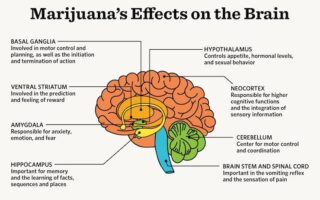In recent years, the conversation surrounding cannabis has evolved dramatically, transitioning from an echo of stigma to a burgeoning realm of scientific inquiry and therapeutic promise. As society grapples with the complexities of this once-taboo plant, its medicinal uses have emerged as a focal point, drawing in patients, researchers, and policymakers alike. From alleviating chronic pain and reducing anxiety to aiding in the management of conditions like epilepsy and multiple sclerosis, the potential of cannabis as a therapeutic agent is both profound and multifaceted. This article embarks on a journey through the intricate landscape of cannabis medicine, exploring its historical roots, the mechanisms behind its effects, and the growing body of research that underscores its role in modern healthcare. Join us as we navigate the promising terrain of cannabis, where tradition meets innovation and the healing possibilities are as expansive as they are intriguing.
Table of Contents
- Exploring the Therapeutic Properties of Cannabinoids
- Effective Strains and Dosages for Common Ailments
- Navigating the Legal Landscape of Medical Cannabis
- Patient Experiences and Expert Recommendations for Safe Use
- Q&A
- Key Takeaways
Exploring the Therapeutic Properties of Cannabinoids
Cannabinoids, the active compounds found in cannabis, have garnered significant attention for their potential therapeutic benefits. Research has indicated that these compounds may interact with the body’s endocannabinoid system, which plays a vital role in maintaining homeostasis. This interaction can lead to a range of positive effects, making cannabinoids a point of interest for various medical applications. Some of the most commonly studied cannabinoids include THC (tetrahydrocannabinol) and CBD (cannabidiol), both of which hold promise for treating conditions such as chronic pain, anxiety, and epilepsy.
Among the multitude of proposed benefits, the following therapeutic properties of cannabinoids stand out:
- Analgesic Effects: Cannabinoids may help alleviate chronic pain and inflammation.
- Anti-Anxiety: Some studies suggest that cannabinoids can reduce symptoms of anxiety and improve mood.
- Neuroprotective Properties: Cannabinoids might protect against neurodegenerative diseases, such as Alzheimer’s and Parkinson’s.
- Appetite Stimulation: Particularly THC has been noted for its ability to increase appetite, beneficial for patients undergoing treatments that affect eating.
Further investigations are underway to elucidate the full range of effects and mechanisms by which cannabinoids operate within the body. A comprehensive overview of cannabinoid applications is provided in the table below:
| Condition | Cannabinoid Type | Potential Benefits |
|---|---|---|
| Chronic Pain | THC, CBD | Reduction in pain perception. |
| Anxiety Disorders | CBD | Decreased anxiety levels and improved coping. |
| Epilepsy | CBD | Reduction in frequency of seizures. |
| Appetite Loss | THC | Increased hunger and caloric intake. |
Effective Strains and Dosages for Common Ailments
Cannabis has established itself as a potential remedy for a variety of ailments, with numerous strains exhibiting unique therapeutic benefits. For those seeking relief from chronic pain, strains such as ACDC and Harlequin are often recommended due to their high CBD content, which can provide pain relief without the psychoactive effects. Similarly, if you’re dealing with anxiety, the calming properties of Lavender and Stormy Daniels may help, offering a more soothing experience while keeping you grounded. Those grappling with insomnia might find success with Granddaddy Purple or Northern Lights, strains celebrated for their sedative effects that can promote a restful night’s sleep.
When considering dosages, it’s essential to start low and go slow, as individual responses to cannabis can vary significantly. For mild symptoms, a dosage of 5-10 mg of THC may be sufficient, while CBD-dominant strains may require 10-20 mg for effective results. Here’s a simplified overview of effective strains along with suggested dosages:
| Condition | Effective Strains | Suggested Dosage |
|---|---|---|
| Chronic Pain | ACDC, Harlequin | 5-10 mg THC |
| Anxiety | Lavender, Stormy Daniels | 5-10 mg THC |
| Insomnia | Granddaddy Purple, Northern Lights | 10-20 mg THC |
Navigating the Legal Landscape of Medical Cannabis
As the popularity of medical cannabis continues to soar, understanding the legal framework surrounding its use is crucial for patients, healthcare providers, and advocates alike. The intricate patchwork of legislation varies not only by country but also by states or provinces within a country, creating a complex landscape that can be challenging to navigate. Key factors influencing this landscape include regulatory bodies, licensing requirements, and qualifying conditions for medical cannabis use. Patients must familiarize themselves with the specific laws in their region to ensure they remain compliant and can access the treatment they need.
Moreover, as laws evolve, so do the implications for research and development in the field of medicinal cannabis. Understanding the regulatory environment can open doors for clinical studies that explore the efficacy of cannabis for various health conditions. The table below summarizes the common medical conditions for which cannabis is often prescribed and the associated legal status in select regions:
| Medical Condition | Legal Status |
|---|---|
| Chronic Pain | Legal in most states |
| Anxiety Disorders | Varies by state |
| Cancer Treatment | Generally legal |
| Epilepsy | Legal in many areas |
| Multiple Sclerosis | Legal with prescription |
Comprehending the ongoing changes in legislation is essential for patients seeking relief through medical cannabis, as well as for healthcare professionals who may guide them through the process. Staying informed about the legal landscape not only empowers users to make educated choices but also paves the way for broader acceptance and integration of cannabis into the medical community.
Patient Experiences and Expert Recommendations for Safe Use
Personal stories from patients who have incorporated medicinal cannabis into their treatment plans illustrate its potential benefits, as well as areas for caution. Many individuals with chronic pain, anxiety, or cancer report finding relief through various cannabis strains. They emphasize that the experience can differ vastly based on factors such as dosage, strain type, and individual tolerance. Commonly shared patient experiences include:
- Improved Sleep Quality: Users frequently mention enhanced sleep patterns, alleviating insomnia symptoms.
- Reduced Anxiety Levels: Medical cannabis has been reported to help decrease anxiety for many patients.
- Appetite Stimulation: Particularly beneficial for those undergoing chemotherapy, certain strains helped restore appetite.
Experts recommend a cautious and informed approach to using medicinal cannabis. They suggest that patients start with a low dose to gauge individual response, gradually increasing the amount as needed. This method helps avoid potential side effects, such as dizziness or increased anxiety. Recommended best practices include:
- Consulting Healthcare Professionals: Always seek guidance from a healthcare provider experienced in cannabis use.
- Keeping a Journal: Documenting effects and dosages can help in determining the best regimen.
- Understanding Legalities: Stay informed about local laws and regulations regarding medicinal cannabis use.
Q&A
Q&A: The Medicinal Uses of Cannabis
Q1: What is cannabis, and how is it used medicinally?
A1: Cannabis, commonly known as marijuana, is a plant that has been utilized for centuries for its therapeutic properties. In the realm of medicine, cannabis is often prescribed in various forms—such as oils, capsules, tinctures, or even inhaled through vaporization—to alleviate symptoms and enhance the quality of life for patients with certain conditions.
Q2: What medical conditions can cannabis help treat?
A2: Research has identified a range of conditions where cannabis may provide relief. These include chronic pain, nausea related to chemotherapy, muscle spasms from multiple sclerosis, anxiety, depression, epilepsy, and glaucoma. Additionally, some studies suggest it may help stimulate appetite in patients undergoing treatments like chemotherapy.
Q3: How does cannabis work in the body to provide these benefits?
A3: Cannabis contains numerous compounds known as cannabinoids, the most notable being THC (tetrahydrocannabinol) and CBD (cannabidiol). THC binds to cannabinoid receptors in the brain, producing psychoactive effects and helping to relieve pain and stimulate appetite, while CBD interacts differently, often noted for its anti-inflammatory and anxiety-reducing properties, without the high associated with THC.
Q4: Are there any risks associated with the medicinal use of cannabis?
A4: Like any medication, cannabis can have side effects. These may include dizziness, dry mouth, fatigue, and changes in mood or appetite. There’s also the potential for dependence or the exacerbation of existing mental health issues, especially in individuals predisposed to conditions such as anxiety or schizophrenia. Therefore, it’s crucial for patients to consult healthcare providers for personalized guidance.
Q5: How is medicinal cannabis different from recreational cannabis?
A5: The primary distinction lies in usage and formulation. Medicinal cannabis is typically cultivated to maximize therapeutic compounds while minimizing psychoactive effects, although some patients may require THC-rich varieties for effective treatment. Recreational cannabis, on the other hand, is often used for its psychoactive effects and may contain varying levels of THC and CBD without a focus on medical benefits.
Q6: What is the legal status of medicinal cannabis?
A6: The legal landscape for medicinal cannabis varies widely by country and, in some places, state or local jurisdiction. In many areas, cannabis can now be prescribed by licensed medical professionals, but it remains heavily regulated with specific eligibility criteria. Patients should stay informed about their local laws to navigate access and usage safely.
Q7: Can cannabis be used alongside other medications?
A7: While cannabis can complement certain treatments, it’s essential for patients to discuss this with their healthcare providers. Some medications may interact negatively with cannabis, altering their effectiveness or increasing side effects. A tailored approach, considering the entire health picture, is vital in ensuring safe and effective treatment regimens.
Q8: What does the future hold for medicinal cannabis research?
A8: The future for medicinal cannabis is promising, with ongoing research exploring its potential benefits and applications. As societal perspectives shift and regulations evolve, there is a growing interest in understanding how cannabis can be integrated into modern medicine, including studies on different strains, dosages, and delivery methods to optimize therapeutic effects.
Q9: How can individuals begin the journey towards using medicinal cannabis?
A9: The first step for those interested in medicinal cannabis is to consult with a healthcare provider knowledgeable in cannabinoid therapies. They can provide insights into the potential benefits, risks, and appropriate strains or products to consider, ensuring a safe and informed path toward wellness.
This Q&A aims to inform readers about medicinal cannabis while encouraging a balanced, inquisitive approach to its uses and implications in healthcare.
Key Takeaways
the journey of cannabis through the realm of medicine is as complex as the plant itself. As we peel back the layers of scientific research and anecdotal evidence, it becomes clear that the potential benefits of cannabis in treating various ailments warrant attention. From alleviating chronic pain to mitigating the symptoms of anxiety and epilepsy, the medicinal properties of this ancient herb continue to spark curiosity and debate.
As more studies emerge and legislation evolves, the landscape of cannabis in medicine is likely to transform further, opening new avenues for treatment and understanding. While the conversation is ongoing, it is essential to approach the subject with curiosity and discernment, recognizing both the promise and the limitations this natural remedy may present. Ultimately, finding a harmonious balance between tradition and modern science may unlock the full therapeutic potential of cannabis, paving the way for a future where its medicinal uses are fully realized and embraced.
As we close this exploration, may we remain open-minded and informed, ready to navigate the evolving narrative of cannabis in health and wellness.


